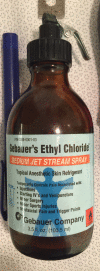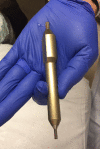Techniques for the Application of Stereotactic Head Frames Based on a 25-Year Experience
- PMID: 27158573
- PMCID: PMC4846396
- DOI: 10.7759/cureus.543
Techniques for the Application of Stereotactic Head Frames Based on a 25-Year Experience
Abstract
The use of skull fixed stereotactic head frames remains an integral part of neurosurgical practice. Methods for the positioning, anesthesia, and fixation have been described in various publications. The authors describe the steps used currently that reflect a 25-year experience with stereotactic frame application. Photographs were obtained throughout the set-up and frame application process. The step-by-step methods were described with accompanying figures. Consent was obtained from that patient to allow for photographs throughout the frame application process. Consent was also obtained from a separate patient for videotaping the entire application process. Descriptive tags are embedded in the video to assist with the instruction of the senior author's (MWM) methods. The senior author has used the described method in over 1,000 cases. A recent analysis of the patient pain experience has been reported and is well tolerated. Supplemental devices beyond the manufacturers' standard equipment have been employed or developed: ethyl chloride spray, angled front posts, frame positioner, and torque wrenches. There have been no shunt perforations, no cranial vault penetrations, one titanium mesh cranioplasty deformation, three pin site infections (3 patients; 4,000 pin sites; 0.075%), and one thermal injury (0.025%). Stereotactic head frame application remains an important part of neurosurgical practice. The steps in application employed here after a 25-year experience appear to make the procedure well tolerated by patients. The authors hope this instructional article will be of value to new users who practice stereotactic radiosurgery, frame-based biopsy, depth electrode placement, or deep brain stimulator implantation.
Keywords: gamma knife; head frame; stereotactic.
Conflict of interest statement
The authors have declared that no competing interests exist.
Figures











References
-
- Angled screw holes for anterior posts and a frame-positioning device for gamma knife radiosurgery: allowing for better targeting of intracranial lesions. Quiñones-Hinojosa A, McDermott MW. Neurosurgery. 2007;60:339–343. - PubMed
-
- In situ cranioplasty for hyperostosing meningiomas of the cranial vault. Bloch O, McDermott MW. Can J Neurol Sci. 2011;38:59–64. - PubMed
-
- Custom-made titanium cranioplasty: early and late complications of 151 cranioplasties and review of the literature. Williams LR, Fan KF, Bentley RP. Int J Oral Maxillofac Surg. 2015;44:599–608. - PubMed
LinkOut - more resources
Full Text Sources
Other Literature Sources
